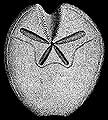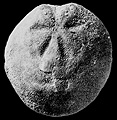The Echinoid Directory
Peribrissus Pomel, 1869, p. 13
| Diagnostic Features |
|
|---|---|
| Distribution | Miocene of North Africa and the Mediterranean. |
| Name gender | masculine |
| Type | Peribrissus saheliensis Pomel, 1869, p. 13, by subsequent designation of Pomel, 1883, p. 36. |
| Species Included |
|
| Classification and/or Status |
|
| Remarks |
|


